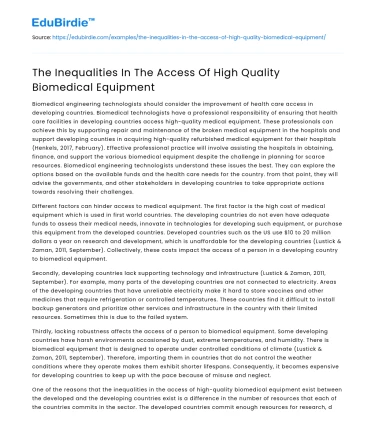Biomedical engineering technologists should consider the improvement of health care access in developing countries. Biomedical technologists have a professional responsibility of ensuring that health care facilities in developing countries access high-quality medical equipment. These professionals can achieve this by supporting repair and maintenance of the broken medical equipment in the hospitals and support developing counties in acquiring high-quality refurbished medical equipment for their hospitals (Henkels, 2017, February). Effective professional practice will involve assisting the hospitals in obtaining, finance, and support the various biomedical equipment despite the challenge in planning for scarce resources. Biomedical engineering technologists understand these issues the best. They can explore the options based on the available funds and the health care needs for the country. from that point, they will advise the governments, and other stakeholders in developing countries to take appropriate actions towards resolving their challenges.
Different factors can hinder access to medical equipment. The first factor is the high cost of medical equipment which is used in first world countries. The developing countries do not even have adequate funds to assess their medical needs, innovate in technologies for developing such equipment, or purchase this equipment from the developed countries. Developed countries such as the US use $10 to 20 million dollars a year on research and development, which is unaffordable for the developing countries (Lustick & Zaman, 2011, September). Collectively, these costs impact the access of a person in a developing country to biomedical equipment.
Save your time!
We can take care of your essay
- Proper editing and formatting
- Free revision, title page, and bibliography
- Flexible prices and money-back guarantee
Secondly, developing countries lack supporting technology and infrastructure (Lustick & Zaman, 2011, September). For example, many parts of the developing countries are not connected to electricity. Areas of the developing countries that have unreliable electricity make it hard to store vaccines and other medicines that require refrigeration or controlled temperatures. These countries find it difficult to install backup generators and prioritize other services and infrastructure in the country with their limited resources. Sometimes this is due to the failed system.
Thirdly, lacking robustness affects the access of a person to biomedical equipment. Some developing countries have harsh environments occasioned by dust, extreme temperatures, and humidity. There is biomedical equipment that is designed to operate under controlled conditions of climate (Lustick & Zaman, 2011, September). Therefore, importing them in countries that do not control the weather conditions where they operate makes them exhibit shorter lifespans. Consequently, it becomes expensive for developing countries to keep up with the pace because of misuse and neglect.
One of the reasons that the inequalities in the access of high-quality biomedical equipment exist between the developed and the developing countries exist is a difference in the number of resources that each of the countries commits in the sector. The developed countries commit enough resources for research, development, and innovation of biomedical equipment. Besides, developed countries invest sufficiently in the maintenance of this equipment that they remain in good working conditions for long. Secondly, misuse and negligence among developing countries are high. Developed countries provide and maintain the required conditions for the various medical equipment, unlike developed countries that lack the supporting technology and infrastructure for most of the biomedical equipment. The third reason is the differences in the level with which the country commits to biomedical equipment. Developed countries have good systems of administration that know how to set their priorities right unlike the developing countries which are occasioned by corrupt practices, among other failures in the systems like misappropriation of funds. These factors collectively are the reasons that inequalities exist in underdeveloped countries.
I think the field of biomedical engineering technology can help in reducing the inequalities related to access to biomedical equipment, especially in developing countries. Biomedical engineering technology can help developing countries access and buy high-quality, low-cost biomedical equipment from developed countries (Henkels, 2017, February). This will prevent the inequality caused by the affordability barrier of high-quality equipment. Secondly, they can offer services to maintain and inspect this equipment to ensure they are working are designed and in the required weather conditions. Doing so will prolong their service life and save the government from spending further funds on the same equipment. Biomedical engineering technology can also find alternatives innovations that will minimize the costs of purchasing or maintaining various biomedical equipment by investing sufficiently in research and development. Consequently, they will develop affordable equipment that promotes high-quality healthcare.
The author means that there is a need for a practical and efficient approach to ensure consistent and optimum results are generated. It is necessary to understand the issues affecting access to high-quality biomedical equipment in developing countries. Doing so will enable the biomedical engineering technologist and opportunity to explore the most efficient approach that can help in the alleviation of the inequalities. Some of the issues in developing countries can be resolved if systematic approaches are followed. The author suggests education and practice in the discipline (Lustick & Zaman, 2011, September). However, I would propose research and development, which will help arrive at the most viable solutions for the inequalities in high quality-biomedical equipment.
References:
- Lustick, D. R., & Zaman, M. H. (2011, September). Biomedical engineering education and practice challenges and opportunities in improving health in developing countries. In 2011 Atlanta Conference on Science and Innovation Policy (pp. 1-5). IEEE.
- Henkels, A. (2017, February). Creating Affordable Access to High-Quality Medical Equipment in Nigeria. Retrieved from https://www.huffingtonpost.co.uk/audrey-henkels/creating-affordable-acces_b_14319212.html?_guc_consent_skip=1569249822






 Stuck on your essay?
Stuck on your essay?

